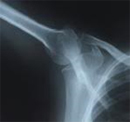Millions of Americans are embracing the adage, “You’re only as old as you feel.” Even though the population of Americans older than 65 is predicted to double within the next 20 years, they’re not going down without a fight. Older Americans want to use every ounce of vitality that life throws at them, and many are trying to help the cause with daily supplements that will keep them moving freely without stiffness and soreness.
“With the demographic for consumers who use bone and joint health products growing in population, living longer, and having a higher standard of living, the bone and joint health market is sure to grow significantly for the foreseeable future,” says Micah Osborne, president of Membrell, Carthage, MO.
A Joint Effort
Whether it’s hinging, rotating or bending, our joints enable our bodies to move in a variety of ways. Joints are found where two bones meet; cartilage and synovial fluid cushion them so the bones don’t grind together and cause pain. With use, age or injury, however, cartilage can wear (or become overgrown) and cause stiffening, inflammation and soreness.
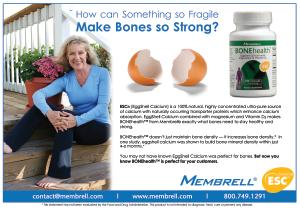 According to the Centers of Disease Control and Prevention, millions of Americans are affected by joint pain. Some 22% of Americans (that’s 46.4 million people!) have arthritis, with about one-quarter of all women affected (1). Over the next 20 years or so, the number could skyrocket to include over 67 million Americans diagnosed with arthritis.
According to the Centers of Disease Control and Prevention, millions of Americans are affected by joint pain. Some 22% of Americans (that’s 46.4 million people!) have arthritis, with about one-quarter of all women affected (1). Over the next 20 years or so, the number could skyrocket to include over 67 million Americans diagnosed with arthritis.
Keeping joints healthy throughout life can be aided by maintaining a healthy weight, exercising, maintaining muscle and knowing your body’s limits. Proper nutrition and supplementation are important, too.
Specialty Supplements. WholeFoods Magazine asked supplement industry insiders to name the top nutrients in this category and one dynamic duo surfaced again and again: glucosamine and chondroitin.
Trisha Sugarek, research and development/technical support specialist, Bluebonnet Nutrition Corporation, Sugar Land, TX, offers insight into how these nutrients work. Glucosamine sulfate, she says, “helps stimulate the manufacture of cartilage components [like glycosaminoglycans (GAGs)] as well as incorporate sulfur into cartilage.”
Our bodies synthesize glucosamine well when we are younger, but we may need supplemental support over time. As a result, says Herb Joiner-Bey, N.D., medical consultant for Barlean’s Organic Oils, Ferndale, WA, “Cartilage loses its gel-like nature and its ability to absorb shock. Inability to manufacture glucosamine may be the major factor leading to osteoarthritis.”
It should be noted that glucosamine sulfate in supplement form can be stabilized with either sodium chloride (NaCl) or potassium chloride (KCl). Sugarek believes “The use of KCl is preferable in this day and age, since the American diet already provides too much salt (NaCl) and not enough potassium. Bluebonnet uses the potassium chloride form.”
Chondroitin sulfate, the other half of this top-selling pair, is naturally present in cartilage, tendons and ligaments “where it is bound to proteins such as collagen and elastin,” Sugarek explains, adding that this nutrient may help contribute to joint strength, flexibility and even shock absorption.
Importantly, chondroitin may help contribute to cartilage regeneration. Therefore, Sugarek says, “with all the necessary tools at hand, the body can effectively manufacture its own cartilage, thus promoting healthy joints.”
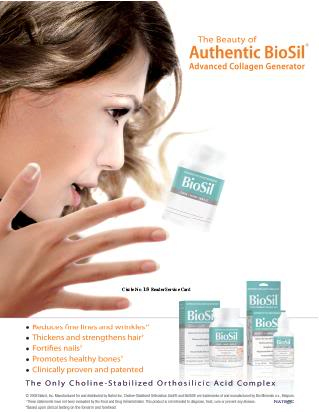 Eileen Sheets, managing director of Bioforce USA, Ghent, NY, describes the Glucosamine/Chondroitin Arthritis Intervention Trial Primary (GAIT) Study, in which National Institute of Health researchers gave glucosamine (1,500 mg daily) and chondroitin (1,200 mg daily) to participants with moderate to severe osteoarthritis pain. “About 79% had a 20% or greater reduction in pain versus about 54% for placebo,” says Sheets. “According to the researchers, because of the small size of this subgroup, these findings should be considered preliminary and need to be confirmed in further studies.” Some 1,500 people participated in the study.
Eileen Sheets, managing director of Bioforce USA, Ghent, NY, describes the Glucosamine/Chondroitin Arthritis Intervention Trial Primary (GAIT) Study, in which National Institute of Health researchers gave glucosamine (1,500 mg daily) and chondroitin (1,200 mg daily) to participants with moderate to severe osteoarthritis pain. “About 79% had a 20% or greater reduction in pain versus about 54% for placebo,” says Sheets. “According to the researchers, because of the small size of this subgroup, these findings should be considered preliminary and need to be confirmed in further studies.” Some 1,500 people participated in the study.
Glucosamine and chondroitin aren’t intended to offer immediate relief, but how do they perform in osteoarthritis patients taking nonsteroidal anti-inflammatory drugs (NSAIDS) for pain relief? According to the University of Maryland Medical Center, “Strong evidence from many well-designed human trials indicates that glucosamine sulfate supplements may be an effective treatment for osteoarthritis (particularly osteoarthritis of the knees). In general, findings from these clinical studies suggest that glucosamine provides several benefits for people with osteoarthritis including pain reduction (as effective as ibuprofen and other non-steroidal anti-inflammatory drugs or NSAIDs), improved function and mobility, and slowed progression or even prevention of joint destruction when taken for three or more years”(2).
Another important nutrient often formulated with glucosamine and chondroitin is methylsulfonylmethane (MSM), a natural sulfur that helps stabilize cartilage, tendons and ligaments. In fact, joint cartilage integrity is said to be “sulfur-dependent” because the molecules that make up cartilage are held together by sulfur bonds. “Recent studies have shown that MSM has a preventative action toward cartilage degeneration, is absorbed quickly and is efficacious at even lower dosages than previously thought,” explains Rodney Benjamin, director of technical development at Bergstrom Nutrition, Vancouver, WA. This nutrient may also work synergistically with calcium to offer bone strength.
And, says Sheets, it helps “inhibit the development of abnormal antibodies to collagen, and prevent the production of rheumatoid factor and antinuclear antibodies.”
Data indicate that MSM has joint pain-relieving properties, but “its clear mechanism of action remains to be elucidated,” says Sheets. “MSM most likely inhibits inflammatory prostaglandins and leukotrienes, hormone-like substances that create inflammatory cascades in the body associated with pain production.”
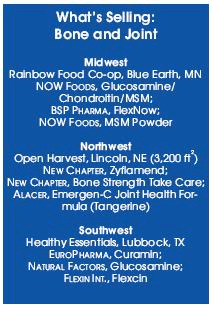 Type II collagen is also an important part of the joint health category. Information from InterHealth Nutraceuticals (a supplier of undenatured type II collagen) notes that supplementation with collagen promotes joint flexibility and mobility through oral tolerization. This process involves helping the body turn on or off an immune response to foreign agents. In InterHealth’s type II collagen, oral supplementation has been “shown to turn off the immune response targeted at the type II collagen present in bone joint cartilage,” says the company (3). The firm also notes a distinction between denatured and undenatured collagen: “According to Dr. David E. Trentham, Harvard University researcher and leading expert on type II collagen, ‘type II collagen must be in its native (undenatured) form to be effective.’”
Type II collagen is also an important part of the joint health category. Information from InterHealth Nutraceuticals (a supplier of undenatured type II collagen) notes that supplementation with collagen promotes joint flexibility and mobility through oral tolerization. This process involves helping the body turn on or off an immune response to foreign agents. In InterHealth’s type II collagen, oral supplementation has been “shown to turn off the immune response targeted at the type II collagen present in bone joint cartilage,” says the company (3). The firm also notes a distinction between denatured and undenatured collagen: “According to Dr. David E. Trentham, Harvard University researcher and leading expert on type II collagen, ‘type II collagen must be in its native (undenatured) form to be effective.’”
Hyaluronic acid (HA) is another important nutrient for joint health. Says Kevin Connolly, Ph.D., director of scientific affairs and product development at Jarrow Formulas, Inc., Los Angeles, CA, “HA builds up the synovial fluid within the joint capsule for lubricating the joint.” HA can bind large amounts of water at the cellular level, which “allows cartilage and collagen cells to ‘gel’ together” (4). Unfortunately with age, HA cannot bind water in the synovial fluids and cartilage as well as it once could, making supplementation important for “replacing and augmenting nature’s naturally occurring lubricant,” says Chris D. Meletis, director of science and research at Trace Minerals Research, Ogden, UT.
And, its weight may make it particularly suitable for joint health. “Evidence suggests that higher molecular weight material has a more reliable effect on joint health,” Connolly explains.
Connolly adds an important mineral to the list: silicon. This trace mineral, he says is needed to make healthy connective tissue, bone, skin, hair and nails. He adds, “Silicon is important for collagen formation, healthy arteries and efficient calcium deposition in bones.” More on this application will be discussed later in this article.
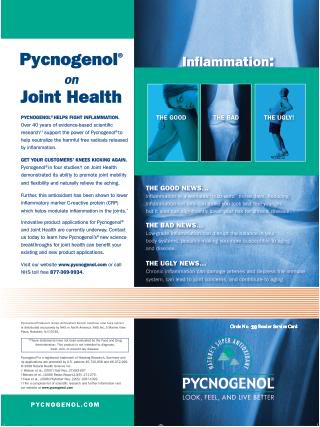 According to Osborne of Membrell, natural eggshell membrane is an important player in the joint health category. Natural eggshell membrane is made of chondroitin, hyaluronic acid, collagen and other nutrients that support joint flexibility. Clinical trials have shown that this ingredient can help “improve joint health and flexibility within 10 days,” he says. A recent study found that the supplement produced a significant decrease in pain and stiffness (up to 26.6%) compared with the placebo at 10, 30 and 60 days (5).
According to Osborne of Membrell, natural eggshell membrane is an important player in the joint health category. Natural eggshell membrane is made of chondroitin, hyaluronic acid, collagen and other nutrients that support joint flexibility. Clinical trials have shown that this ingredient can help “improve joint health and flexibility within 10 days,” he says. A recent study found that the supplement produced a significant decrease in pain and stiffness (up to 26.6%) compared with the placebo at 10, 30 and 60 days (5).
One should also consider supplementation with fatty acids for joint health. According to Joiner-Bey, the EPA in fish oil helps relieve morning joint stiffness and tenderness in rheumatoid arthritis sufferers because it “reduces production of inflammatory compounds secreted by white blood cells and local tissues.” Recent research also indicates that EPA may “switch off” enzymes that degrade and break down joint collagen (6).
Flaxseed oil may be beneficial, too. Joiner-Bey suggests this supplement can inhibit autoimmune reactions (which is helpful for rheumatoid arthritis patients) if dietary omega-6 fatty acids are minimized and one tablespoon of flaxseed oil per 100 pounds of body weight is added.
A patented cetylated fatty acid ingredient (Celadrin from Proprietary Nutritionals, Inc. [PNI], Kearny, NJ) is said to reduce joint pain and inflammation. According to Dean Mosca, president of PNI, the extract, “systematically enhances and lubricates cell membranes throughout the body, providing better cell fluidity and elasticity. This includes the enhancement of fluids that cushion bones and joints to maintain flexibility and mobility.” He also notes this ingredient improved joint pain within 30 minutes in studies.
Herbal Supplements. Plant-based supplements make a major contribution to joint health, many of which address joint inflammation. It is highly important to address inflammation as a cause of osteoporosis, says Leonard P. Smith, chief education officer for BSP Pharma Inc., Egg Harbor Township, NJ. “The wear-and-tear theory’s big hole is whales and dolphins get osteoarthritis, but they’re supported by water their whole lives…There’s not a lot of foot stomping by whales and dolphins,” says Smith.
Researcher Phillip Cheras, Ph.D., an expert on the topic, has analyzed samples of hip joints from those undergoing hip replacement. “When you look at the slides, you can see the fat deposits blocking the joints. You can see the clotting doing the same thing,” says Smith. “This is all made worse by joint-specific inflammation.” Citing a study from Cheras in which exercise was a factor in reduced osteoarthritis risk, Smith notes “vascular diseases [such as high blood pressure] are helped tremendously by exercise…when you stop and look at all the evidence coming in, it makes so much sense that [osteoarthritis] is a vascular disease.” Therefore, he believes, we should zero in on products that are effective against joint-specific inflammation.
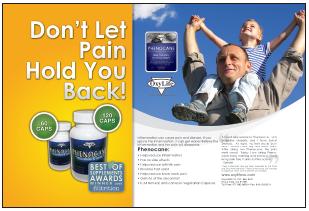 Shea triterpenes (extracted from the pit of the shea fruit) is one such product. According to Smith, this nutrient controls the production of pro-inflammatory cytokines as effectively as steroids, but without the side effects. In addition, this extract is said to reduce the degradation of the collagen (which comprises 70% of cartilage).
Shea triterpenes (extracted from the pit of the shea fruit) is one such product. According to Smith, this nutrient controls the production of pro-inflammatory cytokines as effectively as steroids, but without the side effects. In addition, this extract is said to reduce the degradation of the collagen (which comprises 70% of cartilage).
Other anti-inflammatory herbal extracts, says Eric Anderson, brand manager at P.L. Thomas, Morristown, NJ, include Boswellia serrata and curcumin. For example, a branded Boswellia serrata extract (5-LOXIN) was shown “to provide improvement in joint comfort and flexibility in just seven days with 100 mg daily. These results have also been supported by cytokine data in the blood, showing non-subjective reduction in inflammation biomarkers,” says Anderson.
In this study, researchers gave 75 osteoarthritis patients 100 mg of the Boswellia extract, 250 mg of the extract or a placebo for three months. After this time, the branded ingredient was found to significantly improve pain, joint stiffness and physical function compared with the placebo. And, those taking the 250-mg dose exhibited improvements after just one week (7).
Curcumin, says Joiner-Bey, is important for joint health because it offers anti-inflammatory and antioxidant effects. “Curcumin is as effective as pharmaceutical anti-inflammatories in models of acute inflammation, but without side-effects,” he says.
Sugarek explains that curcumin inhibits the activity of nuclear factor kappa B (NFKB) and cyclooxygenase-2 (COX-2), which causes inflammation. And, it blocks prostaglandin and leukotriene production, which “induces an anti-inflammatory reaction in the body, thus supporting joint health and mobility.”
A paper from scientists at Sabinsa Corporation, Piscataway, NJ bolsters these points. The team cites a curcumin clinical trial on rheumatoid arthritis patients in which the herb had comparable therapeutic effects to the drug, phenylbutazone, for anti-inflammation. The group explains the mechanism of action: “Curcuminoids inhibit enzymes which participate in the synthesis of inflammatory substances in the body derived from arachidonic acid. For example, curcuminoids prevent the synthesis of several inflammatory prostaglandins and prostacyclines” (8).
According to Terry Lemerond, president of EuroPharma, Green Bay, WI, a limitation to some curcumin formulations may be poor, systemic absorption. But, studies on his company’s curcumin supplement (Curamin, which uses the BCM-95 raw ingredient from Dolcas-Biotech) indicate that the supplement was “absorbed 8–10 times more than curcumin 95%.” Lemerond notes that other ingredients (BosPur and DLPA) offer “excellent COX-2 inhibition as well as 5-LOX inhibition enhancing the production of endorphins.”
Extracts from the French maritime pine tree bark (Pycnogenol) also have been shown to reduce joint pain. Says Richard A. Passwater, Ph.D., vice president of research and development at Solgar , Inc. “Pycnogenol may take weeks to set in with noticeable pain relief, however, here the pain relief results from a better joint cartilage condition.”
Pycnogenol works by “calming down” immune cells that are “taking the cartilage under friendly fire,” he says. “This is the prerequisite for having the cartilage recover and this process takes time.”
Much research has been conducted with respect to Pycnogenol and joint health, particularly from Horphag Research. “Pycnogenol has been shown to inhibit the activation of the pro-inflammatory ‘master switch’ NF-kB by 15.8%. Pycogenol was also shown to reduce the inflammatory marker CRP in patients with joint health issues,” says Frank Assumma, director of marketing for Natural Health Science, exclusive North American suppliers of Pycnogenol. “These and many other studies are changing the face of Joint Health right now.”
With respect to osteoarthritis research Frank Schonlau, Ph.D., director of scientific communications at Horphag Research, cites 2008 clinical trial data indicating that the extract “significantly lowers pain and joint stiffness.” He adds, “Pycnogenol is the only bioactive nutrient shown to significantly lower inflammatory marker CRP in patients with osteoarthritis. The lowering of CRP expresses the high anti-inflammatory potency of Pycnogenol.”
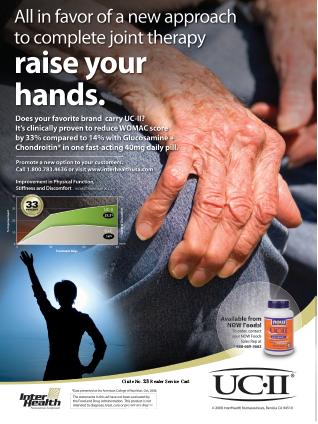 Also on the antioxidant front, Joiner-Bey makes the point that the risk of developing rheumatoid arthritis “is highest in people with lowest levels of nutrient antioxidants.” Therefore, he recommends high antioxidant fruits and vegetables such as fresh olive leaf preparations (including olive leaf extract supplements), greens concentrates, dark berry concentrates and grape seed extracts.
Also on the antioxidant front, Joiner-Bey makes the point that the risk of developing rheumatoid arthritis “is highest in people with lowest levels of nutrient antioxidants.” Therefore, he recommends high antioxidant fruits and vegetables such as fresh olive leaf preparations (including olive leaf extract supplements), greens concentrates, dark berry concentrates and grape seed extracts.
One industry supplier markets a proprietary hops cones extract (Perluxan from PNI) that is said to offer “potent and specific inhibitors of pro-inflammatory chemicals and derivatives, giving Perluxan the ability to reduce pain-causing compounds in a short time with a low dose,” says Mosca. Such compounds, he explains, are of both enzymatic and non-enzymatic origin. They include prostaglandin E2, cyclooxygenase-1+2, interlukein-1, isoprostanes, iNOS and nNOS, TNF-alpha and NF-kappa-B.
In human clinical trials, this hops extract (1,000 mg) was found to reduce pain as well as two ibuprofen tablets (200 mg each). Of note, Mosca says the extract works quickly, sometimes with the first dose.
Research also supports the use of cherry extract for anti-inflammation in the joints. According to Sugarek, they block COX-1 and -2, “which can induce swelling and inflammation in the joints thereby supporting joint health, they have also been shown to lower levels of uric acid in the blood, which is one of the most common causes of gout pain.” She cites studies in which cherries helped decrease uric acid levels in the blood and lessened inflammation associated with gout.
Other important herbs in this category include Bupleurum root (for inflammatory effects and those on corticosteroids to protect against adrenal atrophy) as well as Glycyrrhiza glabra (licorice) and Panax ginseng (which also have anti-inflammatory effects and improve adrenal function).
Story continues below
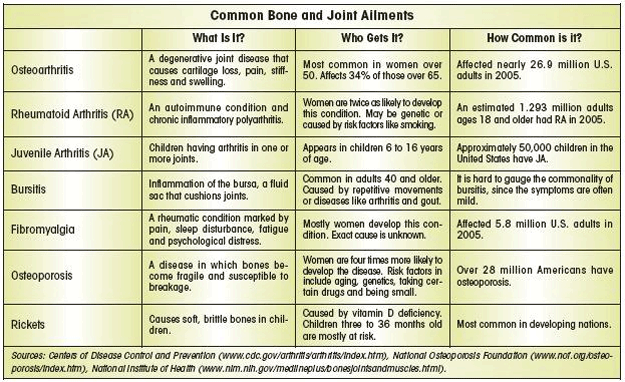
Digging into Topical Relief
While daily supplementation is important for joint health, the natural products arena offers a plethora of high-quality topical aids for fast pain relief. “The body wants to fix and maintain all its cells all the time. Pain is the body’s signaling mechanism to alert us there is a problem, and the body is trying to fix/repair/heal it,” says Lou Paradise, president and chief of research at Topical BioMedics, Rhinebeck, NY. “Healing, of course, is the ultimate form of pain relief, so products that stimulate the most rapid healing response are most valuable to the person suffering and for relieving pain.”
Speaking of a branded anti-inflammatory, pain-relief cream (Topricin), Paradise notes that homeopathic combination products help “relieve pain immediately not by deadening pain symptoms, but by working with the body’s natural chemistries and helping the body heal the damage that is causing the pain.” His company’s cream, for example, combines several botanicals including arnica, Rhus tox, Ruta graveolens, Lachesis muta, belladonna, echinacea, crotalus, aesculus, heloderma, naja and graphites.
Bradley R. West, ND, research advisor to Nordic Naturals, Watsonville, CA, agrees that homeopathics can offer topical relief. “Most will also contain menthol and camphor, widely known to help provide immediate relief. There are many more options out there that nature and many brilliant companies have provided,” he says.
Bob Shawgo, vice president of marketing at Bioforce Group, Pleasant Grove, UT, suggests that many natural topical products are superior to pain relievers that use salicylates or non-steroidal anti-inflammatories like ibuprofen. “These leave behind toxins that can cause severe blood and organ problems.”
Consumers need not worry that natural products aren’t strong enough to deal with deep tissue pain. “Arthritis pain doesn’t start in a person’s skin, yet most pain creams stop there. Arthritis pain is in the deeper tissue of joints, tendons and muscles,” says Shawgo. His company has patented a natural phospholipid delivery system for its cream (Myo-Med) that “carries pain-relieving and anti-inflammatory ingredients past the dermal and fat (lipid) layers for deep tissue relief.” And, vitamin E is used “to create a smooth, easy to rub on texture that softens and restores skin as it’s applied.”
Paradise says his company’s cream helps “the body heal damage in the soft tissue around joint, muscle and nerve tissue as a result of its ability to detoxify the affected area, and restore blood flow back to normal. This is vital to help the body deliver the necessary oxygen and nutrients required to maintain healthy joint/bone tissue and function.”
Last, Sheets notes that non-homeopathic arnica gel also offers relief by “inhibiting the way that NF-kB works in the body.” NF-kB is switched on when inflammation begins. “By inactivating Nf-kB, inflammatory process can be stopped at the very beginning…One clinical study showed A. Vogel Arnica Rub to be as effective as ibuprofen gel in relieving stiffness and pain associated with osteoarthritis of the fingers,” Sheets explains.
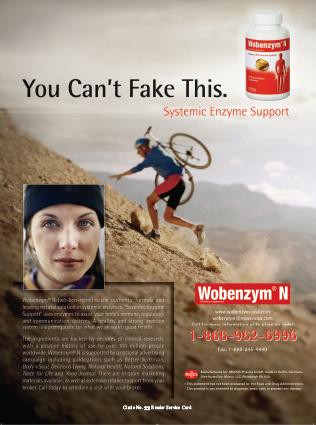 The Bare Bone Facts
The Bare Bone Facts
Too often, bone health advice is oversimplified into “take calcium for strong bones.” While it’s true that we should consume sufficient quantities of this mineral daily, there’s far more to the bone health picture. Our bones are living, growing tissue composed of collagen and calcium phosphate; several important nutrients help hold our bone structure together giving it both rigidity and a degree of flexibility (9).
Says Shawgo, “In the area of bone health, a lot of emphasis seems to be put on calcium, however, we believe that the body is a full system and requires a full range of nutrients and antioxidants as part of a bone health regimen.”
Passwater agrees and adds, “Bone health involves more than the major minerals of which bone consists. Bone health involves the nutrients required for the biochemical pathways of producing bone and the nutrients required for the materials that hold the major bone materials together…healthy bone is not just piles of calcium and phosphate minerals sitting loosely one on top of another.”
In fact, several important nutrients support the bone mineralization and resorption process. Throughout our lives, old bone is removed while new bone is added. Until we reach over early 30s, our bone growth outpaces our bone loss. After that time (especially after women reach menopause), bone resorption picks up (9).
Vitamin K (especially K2) is key for this process. Referencing clinical trials conducted on the matter, Passwater states, “Whereas vitamin K1 was shown to reduce bone loss by 35%, vitamin K2 could completely prevent the loss of bone strength in postmenopausal women. The effect of vitamin K is via the activation of the vitamin K-dependent bone protein called osteocalcin.”
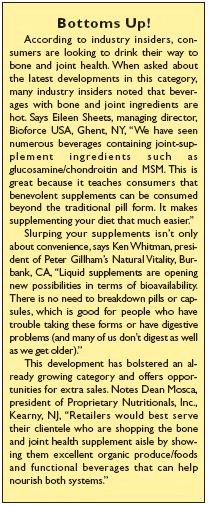 This nutrient also is linked to heart health. Says Anderson, “Without adequate vitamin K in the diet, the body cannot metabolize calcium to build healthy bones and it can settle in the arteries.“ Recent Vitamin Connection columns published in WholeFoods Magazine underscore this point with information showing vitamin K2 can decrease arterial calcification and the risk of heart attack (see February and March 2009 issues).
This nutrient also is linked to heart health. Says Anderson, “Without adequate vitamin K in the diet, the body cannot metabolize calcium to build healthy bones and it can settle in the arteries.“ Recent Vitamin Connection columns published in WholeFoods Magazine underscore this point with information showing vitamin K2 can decrease arterial calcification and the risk of heart attack (see February and March 2009 issues).
One must also note the importance of silicon in the bone health category. As mentioned previously, collagen is a key component in bone that serves as a binding site for calcium and adds flexibility. Silicon is necessary for two “critical enzymes” in the collagen process, says Passwater. “If the actions of these two enzymes are impaired by silicon deficiency, the difference in collagen production can be great. Conversely, a small amount of additional organic-form dietary silicon to stimulate or facilitate the efficiency of these two enzymes can significantly improve collagen production.”
A published essay from Bio Minerals notes that the mineral helps calcium bind to collagen, which increases bone mineral density. In trials on its patented choline-stabilized orthosilicic acid complex (BioSil), bone mineral density increased 200% in subjects taking this supplement (10).
Now, let’s circle back to calcium. You can’t build bones without calcium, but which form of calcium is best? Experts say that calcium carbonate contains the most elemental calcium per tablet; calcium phosphate has the second highest elemental calcium levels; calcium citrate is said to be one of the best absorbed forms; calcium ascorbate combines vitamin C; and calcium gluconate and lactate are said to be absorbed well in the body (11).
Osborne notes the importance of the calcium source. Eggshell calcium, he believes, is “one of nature’s purest, most absorbable calciums.” He says that this form “combines a natural form of calcium carbonate with the inherent proteins nature requires for calcium absorption. “ In fact, eggshell calcium is made of several trace minerals that the body needs to increase bone mineral density. “And, it all comes from nature’s perfect food: the egg,” says Osborne.
Other calcium sources include coral calcium, oyster shell and microcrystalline hydroxyapatite from bone.
Calcium nearly always appears in nature with magnesium, which benefits bone health for several reasons. First, it stimulates that hormone calcitonin, which helps move calcium from the blood and into the bones. It also suppresses parathyroid, a hormone that breaks down bone. And, magnesium converts vitamin D into its active form and activates an enzyme that forms new bone (12).
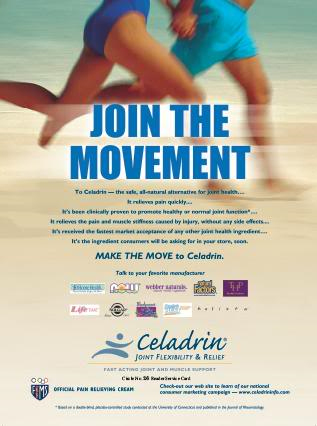 But Ken Whitman, president of Peter Gillham’s Natural Vitality, Burbank, CA, makes the point that a proper balance of calcium and magnesium is of the utmost importance. Having a low magnesium-to-calcium ratio can result in an inflammatory response and damage cells and the body. In fact, the situation can become cyclical as too much calcium can impede magnesium absorption. Whitman cites Nan Kathryn Fuchs, Ph.D., in her book, User’s Guide to Calcium & Magnesium, to illustrate the point that it is easy for the magnesium–calcium balance to become disproportionate: “When you take more calcium than you can use, the extra calcium isn’t automatically excreted. In fact, it can contribute to uncomfortable and dangerous conditions like arthritis and heart disease. The key is to take the right amount of a well-absorbed form of calcium along with other nutrients needed to help it work.”
But Ken Whitman, president of Peter Gillham’s Natural Vitality, Burbank, CA, makes the point that a proper balance of calcium and magnesium is of the utmost importance. Having a low magnesium-to-calcium ratio can result in an inflammatory response and damage cells and the body. In fact, the situation can become cyclical as too much calcium can impede magnesium absorption. Whitman cites Nan Kathryn Fuchs, Ph.D., in her book, User’s Guide to Calcium & Magnesium, to illustrate the point that it is easy for the magnesium–calcium balance to become disproportionate: “When you take more calcium than you can use, the extra calcium isn’t automatically excreted. In fact, it can contribute to uncomfortable and dangerous conditions like arthritis and heart disease. The key is to take the right amount of a well-absorbed form of calcium along with other nutrients needed to help it work.”
Other minerals are helpful for bone health. Potassium “prevents the release of calcium from bones for maintaining pH for calcium resorption,” says Connolly. And, boron “reduces urinary calcium excretion and dramatically increases the bone-building effects of 17-beta-estradiol, the most biologically active estrogen. Boron is required to activate certain hormones, including estrogen and vitamin D. Boron is also required to convert vitamin D to its most active form in kidneys,” says Joiner-Bey.
On the vitamin front, we cannot forget about vitamin D. Much has been said lately in the medical community about vitamin D deficiency in Americans. In an effort to protect their skin from ultraviolet rays, many individuals slather on sunscreen or stay indoors. While this is great for skin health, it is contributing to vitamin D deficiency as the body naturally metabolizes this vitamin from sunlight. Lack of vitamin D is a critical topic in relation to bone health because this vitamin helps stimulate calcium absorption in the intestines. Not consuming enough of this vitamin can cause low bone mass.
It should be noted that many medical associations have petitioned the U.S. Food and Drug Administration to increase its recommendations for vitamin D consumption. The current recommended daily allowance for vitamin D is for healthy children and adults to take 200 IU of the vitamin daily. But, the American Medical Association asked the government in 2008 to change this amount to 400 IU per day, and some experts have suggested even more than that (1,000–2,000 IU daily).
|
Select Bone and Joint Products Barlean’s Organic Oils offers Barlean’s Organic Flaxseed Oil, Barlean’s Fresh Catch Fish Oil and Cod Liver Oil, Barlean’s Omega Swirl Fish Oil and Flaxseed Oil, Barlean’s Greens, Barlean’s Olive Leaf Complex. Bergstrom Nutrition’s offerings include OptiMSM and Vitamin K27. Bergstrom’s sister company, TandemRain Innovations is the exclusive marketer of ActivMSM, a GRAS-designated MSM ingredient. Bioforce Group markets Myo-Med, Joint Plus, Vital Kinetic and Prolytes. Bioforce USA distributes Arnica Rub (3.5-fl-oz. size) for use as needed. Bluebonnet Nutrition makes Cherry Fruit Extract Vcaps, Osteo-Bone Formula Vcaps, Liquid Calcium Magnesium Citrate, Calcium Citrate Magnesium Plus Vitamin D3 Caplets, Turmeric Root Extract Vcaps (with Curcuma C3 Complex from Sabinsa), Glucosamine Chondroitin Plus MSM Vcaps and GSX Formula Vcaps. BSP offers FlexNow Joint Formula (shea triterpenes). Dolcas-Biotech supplies BCM-95 and BosPur. EuroPharma makes Curamin, Dyflaminol and Arthocin for joint health as well as OsteoStrong and Strontium for bone health. InterHealth Nutraceuticals supplies UC II type II undenatured collagen. Jarrow Formulas, Inc. makes Bone-Up Ultra Joint Builder and JarroSil activated silicon formula. Membrell offers JOINTHealth with NEM (Natural Eggshell Membrane) and BONEHealth with ESC (Eggshell Calcium). Mucos makes Wobenzym N, a systemic enzyme for a healthy immune system and joints. Natrol offers BioSil as well as glucosamine, MSM and chondroitin. Natural Health Science (NHS) is the supplier of Pycnogenol. Nordic Naturals makes high-potency fish oil formulas as well as several that incorporate vitamin D3 such as Arctic-D Cod Liver Oil, Omega-D3 and Ultimate Omega-D3. Peter Gillham’s Natural Vitality offers Osteo Calm, a liquid formula for bone health support. PL Thomas is the supplier of MenaQ7 Natural Vitamin K2 as Mk-7 and 5-LOXIN. PNI supplies Celadrin and Perluxan. Sabinsa Corporation offers Curcumin C3 Complex as a raw ingredient. Schiff Nutrition offers bone and joint products including calcium, magnesium, glucosamine, chondroitin and more. Solgar, Inc. manufactures Vitamin D in several forms, Natural Vitamin K2 (MK-7) 100 mcg Vegetable Capsules, Vitamin C, Calcium, MSM, Glucosamine, Chondrotin MSM and Pycnogenol. Topical BioMedics Inc. offers Topricin Pain Relief and Healing Cream, Topricin Junior Pain Relief and Healing Cream, Topricin Foot Therapy Pain Relief and Healing Cream, Glucosamine complex. Trace Minerals Research makes ActivJoint, Liquid Calcium/Mag/Zinc, Liquid Glucosamine/Chondroitin/MSM, Liquid Glucosamine/MSM, Vegetarian Arth-X, Arth-X Plus, Arth-X Platinum, and Glucosamine/Chondroitin/MSM tablets. |
Therefore, many supplement makers pair vitamin D and calcium in their formulations. One can also get vitamin D in certain fish oils such as cod liver oil. Fish oil is beneficial on other fronts, too. West of Nordic Naturals makes the point that fish oil’s anti-inflammation properties may help maintain strong bones. Research indicates that chronic inflammation supports osteoclast activity (which breaks down bone) and disrupts osteoblast activity (which re-builds them). ”Chronic inflammation is one of the main effects of a dietary deficiency of omega-3 fats and excess of omega-6, as is the case with a standard American diet. Recent findings indicate that an omega-3 rich diet is positively associated with bone density,” he states.
Bisphosphonates and Supplements
If you talk about bone health with your clientele, be prepared to hear “I’m covered. I take Fosamax.” It is estimated that tens of millions of Americans take bisphosphonates, a class of drugs marketed as Actonel, Boniva, Fosamax, Reclast and others that prevents and treats osteoporosis. While it’s not a retailer’s job to encourage or discourage treatment suggested by a physician, there are a few things sales personnel should know about these drugs when dealing with shoppers who use them.
First, these drugs and dietary supplements don’t exist in two separate worlds. In fact, Osborne notes that they work synergistically for bone health. “Bisphosphonates are used in the treatment of osteoporosis and work by inhibiting bone resorption by osteoclasts. Adequate calcium and vitamin D are still necessary components in order to build bone and are therefore excellent adjuvant therapies,” he explains.
Sheets adds, “Depending upon the physician’s recommendation for the individual patient, we encourage retailers to encourage their middle-aged female consumers to review the best supplements available that nurture the structure and function of joints and work with their doctors to enjoy the benefits of both the pharmaceutical and the dietary supplement.”
Paradise points out, however, that many bisphosphonates have been linked with side effects including back, muscle and joint pain, dizziness, nausea and infections. And, some side effects are serious, he says: “Fosamax has been linked to severe musculoskeletal pain (pain of the joints, muscles, and/or bones), as well as osteonecrosis of the jaw (ONJ) also known as ‘dead jaw.’ An article on the association between Fosamax and ONJ was first published in the Journal of Oral and Maxillofacial Surgeons, which prompted the US Food and Drug Administration (FDA) to review the safety of Fosamax and other drugs in its class (bisphosphonate drugs).”
Paradise and many others interviewed for this article feel that the best advice for bone health is to take preventative actions before problems start. Says Anderson, “We recommend a healthy lifestyle, including supplements and food sources that support bone health throughout life. The better bone mass built early in life protects against the loss over time—so good practices in youth help promote quality of life as we age…After peak bone mass is reached around 30 years of age, we lose bone slowly as we age. Therefore, the more healthy bone built, the better the long-term outcome.”
West seconds this sentiment. “Bone loss is a sign of poor diet and lifestyle choices…This is where supplementation can be very supportive. I would implore consumers facing this situation to look for the information and guidance in what can be done naturally to stop and even reverse bone loss. Areas such as weight-training and mineral-rich alkalizing diets would be key, with special attention to the minerals.”
And, retailers should take care to explain that osteoporosis sufferers may be deficient in several bone-supporting nutrients that are not replenished with a prescription. “Millions of people in the United States alone are, for instance, vitamin D deficient, including a large percentage of individuals taking prescription medication for osteoporosis,” says Meletis of Trace Minerals. “The question to ask is not so much whether to take a medication when needed, rather, would it not be wise to support the 75 trillion cells with the building blocks needed to sustain health?” WF
References
- Centers for Disease Control and Prevention, “NHIS Arthritis Surveillance,” www.cdc.gov/arthritis/data_statistics/national_data_nhis.htm, accessed April 18, 2009.
- University of Maryland Medical Center, Complementary and Alternative Medicine Index, www.umm.edu/altmed/, accessed April 18, 2009.
- InterHealth Nutraceuticals, www.interhealthusa.com/Ingredients/UC-II.aspx, accessed April 18, 2009.
- M. Zimmerman and J. Krone, 7-Syndrome Healing (Nutrition Solutions Publications, Chino, CA, 2006).
- K.J. Ruff, et al., “Eggshell Membrane in the Treatment of Pain and Stiffness from Osteoarthritis of the Knee: A Randomized, Multicenter, Double-Blind, Placebo-Controlled Clinical Study,” Clin. Rheum., published online April 2, 2009.
- J.C. Maroon and J. Bost, Fish Oil: The Natural Anti-Inflammatory (Basic Health Publications, Laguna Beach, CA, 2006).
- K. Sengupta, et al., “A Double Blind, Randomized, Placebo Controlled Study of the Efficacy and Safety of 5-Loxin® for Treatment of Osteoarthritis of the Knee,” Arthritis Res. Ther. 10 (R85) (2008).
- M. Majeed, L. Prakash and V. Badmaev, “Curcuminoids: Bioprotectant Compounds from Turmeric,” www.sabinsa.com/paper_curcumin.htm, accessed April 20, 2009.
- National Institutes of Health, Osteoporosis and Related Bone Diseases National Resource Center, Osteoporosis Overview, January 2009.
- BioSil 2009: The “Year of Collagen” for Women, WholeFoods Magazine 32 (2) 48 (2009).
- G. Spiller and B. Bruce, Calcium: Nature’s Versatile Mineral (Avery, New York, NY, 2000).
- C. Dean, The Magnesium Miracle (Ballantine Books, New York, NY, 2007).
Published in WholeFoods Magazine, June 2009


